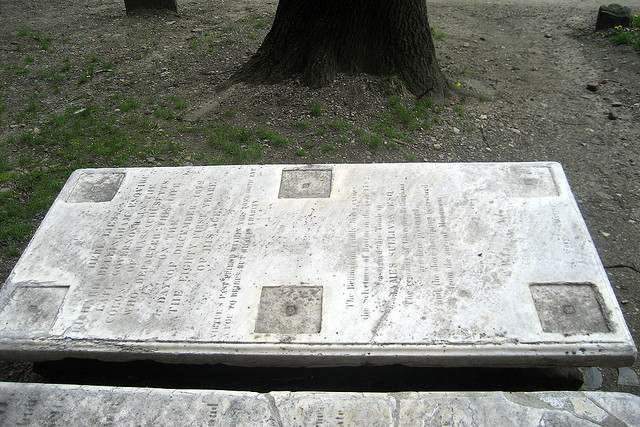 |
| Granary Burying Ground, from the innermost side looking out. |
When I've talked previously about the Trial of Anne Hutchinson game, I've talked a lot about John Winthrop. If the goal of this blog is to find connections between teaching history and everyday life, John Winthrop makes for a rich source because he has been so aggressively memorialized through place, as I noted in my discussion of Boston Common and Winthrop Lane; through the wide availability of his writings, such as his conversion narrative; and through the continual recycling of the myth that the United States is the "citty upon a hill" of which Winthrop wrote.
However, I was delighted to find a slightly less-discussed figure from the Anti-Anne faction on my trip to Boston's Granary Burying Ground, the third-oldest cemetery in the city (citty?) Most of the attention at the Burying Ground is lavished on the who's-who of the American Revolutionary set-- Paul Revere, John Hancock, Samuel Adams, and Benjamin Franklin...'s parents are all resting comfortably here, as well as the victims of the Boston Massacre and the grave of Increase Mather. The slide show below has a few of my photos of these Revolution-era graves.
However, a (truly filthy) sign along the pathway revealed that none other than your old friend and mine, Richard Bellingham, also lay within the gates of the burying ground.
 |
| Sign mentioning Bellingham's burial site along with another Massachusetts governor in Tomb 146. |
There are several interesting reasons to recall Bellingham; when he is remembered it is most frequently not as a historical figure but as a character in Nathaniel Hawthorne's The Scarlet Letter. The historical Bellingham ran against Winthrop for the governorship in 1641 and served as the Massachusetts Bay Colony's eighth, sixteenth, and eighteenth governor. He was also influential in persecuting Quakers, including some of the pro-Anne faction, and Bellingham, Massachusetts is named after him.
All of this, however, apparently pales in comparison to the delights of historical gossip. The sign recalls another tidbit that I've mentioned in postmortem chats after the Anne Hutchinson trial-- his scandalous self-performed marriage to a much younger woman. Such drama! The 1919 History of the Town of Bellingham, 1719-1919 quotes Winthrop (again with Winthrop! The man had an opinion on everyone and everything, I tell you):
The young woman was ready to be contracted to a friend of his, who had lodged in his house and by his consent had proceeded so far with her, when on a sudden the Governor treated with her and obtained her for himself. He excused it by the strength of his affection, and that she was not absolutely promised to the other gentleman. Two errors more he committed on it. First that he would not have his marriage contract published where he dwelt, contrary to an order of court, and second that he married himself, contrary to the constant practice of the country (7).
Sadly, it is impossible to get close to Bellingham's resting place, as the pathways do not go near it and are pretty strictly cordoned off from the graves. However, the shot below gives a fairly good view of the top of the tomb, which details the two inhabitants and tells us that Bellingham died in 1672 at the age of 81.
 |
| This photo, from Find a Grave, is far better than any of the ones I was able to take. |
Related Links:
This video is a fun intro to the Granary Burying Ground and its inhabitants.
Enough About Me: I once played Pearl Prynne in an adaptation of The Scarlet Letter. Freddie Tate portrayed Bellingham.
You may notice another familiar name in this character list for The Scarlet Letter-- John Wilson, minister of the First Church of Boston, also makes an appearance.
Enough About Me: I once played Pearl Prynne in an adaptation of The Scarlet Letter. Freddie Tate portrayed Bellingham.
You may notice another familiar name in this character list for The Scarlet Letter-- John Wilson, minister of the First Church of Boston, also makes an appearance.


![Blackstone briefly returned to Boston in 1659 riding on a bull. [citation needed]](https://blogger.googleusercontent.com/img/b/R29vZ2xl/AVvXsEiXMXDmBkqUXy6p__8aD6FIknc5oFgeVdSoL_3oxGNqPCqtP2d8t3qJlPYq7lBGOegBZY6Y3fhbAXAARamhc8xt88cgGu6nuyG5lTzxZ5dRtUW2FAC5WsLYqZX_6l2WDve25Q2yuQCEVviQ/s640/Inkedblaxton+bull_LI.jpg)